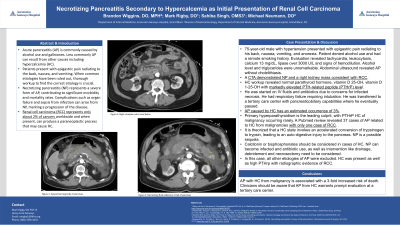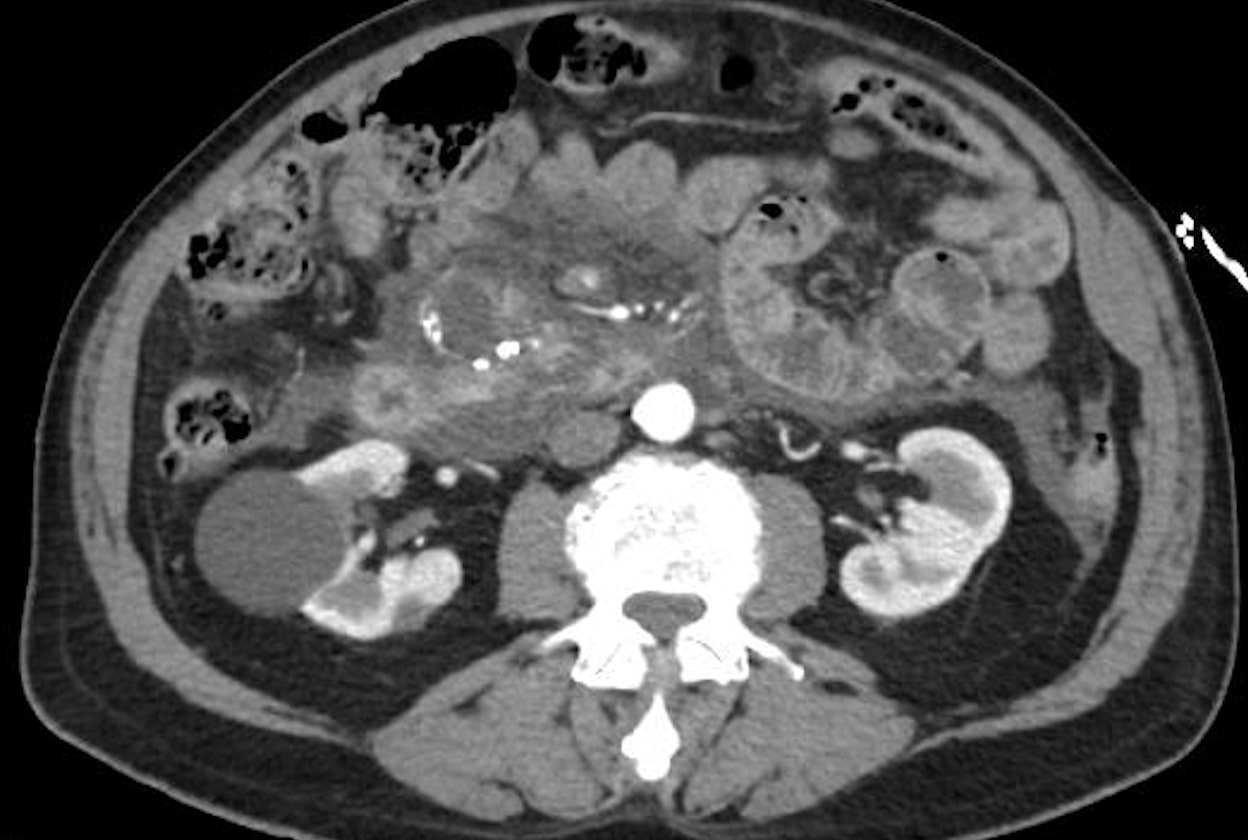Sunday Poster Session
Category: Biliary/Pancreas
P0078 - Necrotizing Pancreatitis Secondary to Hypercalcemia as Initial Presentation of Renal Cell Carcinoma
Sunday, October 27, 2024
3:30 PM - 7:00 PM ET
Location: Exhibit Hall E

Has Audio

Brandon T. Wiggins, DO, MPH
Ascension Genesys Hospital
Grand Blanc, MI
Presenting Author(s)
Brandon T. Wiggins, DO, MPH1, Mark Rigby, DO2, Sahiba Singh, BS3, Michael Neumann, DO1
1Ascension Genesys Hospital, Grand Blanc, MI; 2Ascension Genesys, Grand Blanc, MI; 3Ascension Genesys Hospital, Troy, MI
Introduction: Acute pancreatitis (AP) is commonly caused by alcohol use and gallstones. Less commonly AP can result from other causes including hypercalcemia (HC). Patients present with epigastric pain radiating to the back, nausea, and vomiting. When common etiologies have been ruled out, thorough workup to find the correct etiology is crucial.
Necrotizing pancreatitis (NP) represents a severe form of AP, contributing to significant morbidity and mortality rates. Complications such as organ failure and sepsis from infection can arise from NP, marking a progression of the disease.
Renal cell carcinoma (RCC) represents only about 2% of cancers worldwide and when present, can produce a paraneoplastic process that may cause HC.
Case Description/Methods: 75 year old male with hypertension presented with epigastric pain radiating to his back, nausea, vomiting, and anorexia. Patient denied alcohol use and had a remote smoking history.
Evaluation revealed tachycardia, leukocytosis, calcium 13 mg/dL, lipase over 3000 U/L and signs of hemodilution. Alcohol level and triglycerides were unremarkable. Abdominal ultrasound revealed AP without cholelithiasis.
A CTA demonstrated NP and a right kidney mass consistent with RCC. HC workup revealed normal parathyroid hormone, vitamin D 25-OH, vitamin D 1-25-OH with markedly elevated PTH-related peptide (PTHrP) level. He was started on IV fluids and antibiotics due to concerns for infected necrosis. He had respiratory failure requiring intubation. He was transferred to a tertiary care center with pancreaticobiliary capabilities where he eventually passed.
Discussion: AP caused by HC has an estimated occurrence of 3%. Primary hyperparathyroidism is the leading culprit, with PTHrP HC of malignancy occurring rarely. A Pubmed review revealed 37 cases of AP related to HC from malignancies with only one case of RCC. It is theorized that a HC state invokes an accelerated conversion of trypsinogen to trypsin, leading to an auto-digestive injury to the pancreas. NP is a possible sequelae. Calcitonin or bisphosphonates should be considered in cases of HC. NP can become infected and antibiotic use, as well asvintervention like drainage, debridement and necrosectomy need to be considered. In this case, all other etiologies of AP were excluded. HC was present as well as high PTHrp with radiographic evidence of RCC.
AP with HC from malignancy is associated with a 3-fold increased risk of death. Clinicians should be aware that AP from HC warrants prompt evaluation at a tertiary care center.

Disclosures:
Brandon T. Wiggins, DO, MPH1, Mark Rigby, DO2, Sahiba Singh, BS3, Michael Neumann, DO1. P0078 - Necrotizing Pancreatitis Secondary to Hypercalcemia as Initial Presentation of Renal Cell Carcinoma, ACG 2024 Annual Scientific Meeting Abstracts. Philadelphia, PA: American College of Gastroenterology.
1Ascension Genesys Hospital, Grand Blanc, MI; 2Ascension Genesys, Grand Blanc, MI; 3Ascension Genesys Hospital, Troy, MI
Introduction: Acute pancreatitis (AP) is commonly caused by alcohol use and gallstones. Less commonly AP can result from other causes including hypercalcemia (HC). Patients present with epigastric pain radiating to the back, nausea, and vomiting. When common etiologies have been ruled out, thorough workup to find the correct etiology is crucial.
Necrotizing pancreatitis (NP) represents a severe form of AP, contributing to significant morbidity and mortality rates. Complications such as organ failure and sepsis from infection can arise from NP, marking a progression of the disease.
Renal cell carcinoma (RCC) represents only about 2% of cancers worldwide and when present, can produce a paraneoplastic process that may cause HC.
Case Description/Methods: 75 year old male with hypertension presented with epigastric pain radiating to his back, nausea, vomiting, and anorexia. Patient denied alcohol use and had a remote smoking history.
Evaluation revealed tachycardia, leukocytosis, calcium 13 mg/dL, lipase over 3000 U/L and signs of hemodilution. Alcohol level and triglycerides were unremarkable. Abdominal ultrasound revealed AP without cholelithiasis.
A CTA demonstrated NP and a right kidney mass consistent with RCC. HC workup revealed normal parathyroid hormone, vitamin D 25-OH, vitamin D 1-25-OH with markedly elevated PTH-related peptide (PTHrP) level. He was started on IV fluids and antibiotics due to concerns for infected necrosis. He had respiratory failure requiring intubation. He was transferred to a tertiary care center with pancreaticobiliary capabilities where he eventually passed.
Discussion: AP caused by HC has an estimated occurrence of 3%. Primary hyperparathyroidism is the leading culprit, with PTHrP HC of malignancy occurring rarely. A Pubmed review revealed 37 cases of AP related to HC from malignancies with only one case of RCC. It is theorized that a HC state invokes an accelerated conversion of trypsinogen to trypsin, leading to an auto-digestive injury to the pancreas. NP is a possible sequelae. Calcitonin or bisphosphonates should be considered in cases of HC. NP can become infected and antibiotic use, as well asvintervention like drainage, debridement and necrosectomy need to be considered. In this case, all other etiologies of AP were excluded. HC was present as well as high PTHrp with radiographic evidence of RCC.
AP with HC from malignancy is associated with a 3-fold increased risk of death. Clinicians should be aware that AP from HC warrants prompt evaluation at a tertiary care center.

Figure: Transverse View Computed Tomography of Necrotizing Pancreatitis and Renal Cell Mass
Disclosures:
Brandon Wiggins indicated no relevant financial relationships.
Mark Rigby indicated no relevant financial relationships.
Sahiba Singh indicated no relevant financial relationships.
Michael Neumann indicated no relevant financial relationships.
Brandon T. Wiggins, DO, MPH1, Mark Rigby, DO2, Sahiba Singh, BS3, Michael Neumann, DO1. P0078 - Necrotizing Pancreatitis Secondary to Hypercalcemia as Initial Presentation of Renal Cell Carcinoma, ACG 2024 Annual Scientific Meeting Abstracts. Philadelphia, PA: American College of Gastroenterology.
